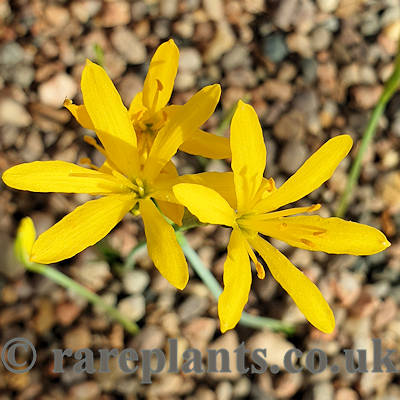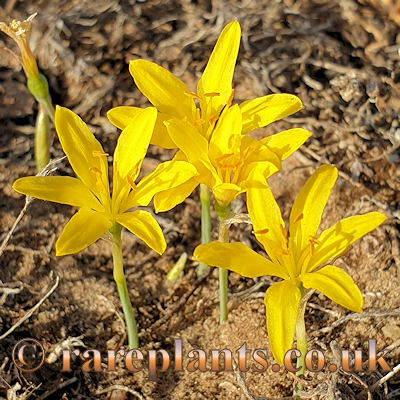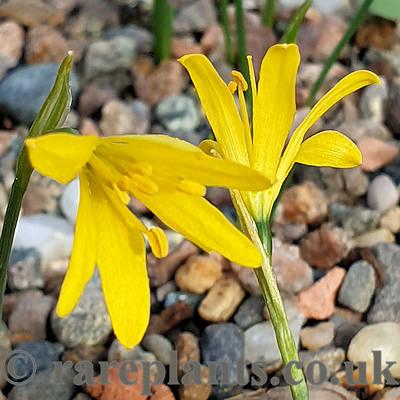Description
(syn. Amaryllis exigua, Braxireon humile, Carregnoa humilis, C. lutea, Gymnoterpe humile, Lapiedra gracilis, Narcissus humilis, Oporanthus exiguus, Pancratium humile, Sternbergia exigua, Tapeinaegle humilis, Tapeinanthus humilis)
This is a rare, very dwarf, autumn-flowering species once known (mainly) as Tapeinanthus humilis, with a host of other synonyms. Taxonomists rechristened it to Narcissus humilis before an earlier name was dredged up and it became Narcissus cavanillesii. This simplified version of its naming history ignores the myriad of invalid, earlier names.
It is considered to be a primitive, autumn-flowering Narcissus, which lacks a significant corona (the trumpet) and which has its petals fused at the base into a short tube. It is native to Southern Spain and North Africa only.
It flowers as soon as growth begins. This can be from September through October and even into early November. The flowers are quoted as 10-25mm in diameter though I have never seen one larger than 15mm and many are just 10mm. They are a stunning, very bright yellow. The trumpet is vestigial (virtually absent) and hard to see unless you know it actually exists, know just where to look and just what to look for.
Bulbs of flowering size are tiny, I repeat The Bulbs Are Tiny, please expect something less than the size of even a small pea. The tiny bulbs usually make only one leaf, this is very narrow and sometimes, usually when making a flower, the plant will make no leaves at all, relying instead on the flower stem for photosynthesis, a phenomenon shared with both Narcissus serotinus and N. viridiflorus which are similarly primitive and also autumn-flowering. N. cavanillesii hybridises in the wild with both of these species (and with others) to yield some really lovely offspring, but the yellow parent itself has a charm and delicacy which I adore.
With a height of only about 8-12 cm (with us) this is ideal for pot cultivation under cold, or alpine, glass and the bulbs can be packed into a small pot. This is a charming little daffodil steeped in evolutionary significance. It likes a really well-drained, loam soil, which is very dry in summer. It should be noted, that unless you get the conditions right, this will be shy-flowering. Yearly flowering isn’t something to be expected unless you are skilled or a bit lucky. It is however easier to grow and flower than most of the other autumnal Narcissus species. The trick seems to lie in giving the plant quite a severe summer rest, leaving it undisturbed in its compost if possible. We then flood with dilute fertiliser, once, in August and leave it, until resuming normal watering (with further feeding) in September. Deeper than usual planting is one idea that seems to work, as far down as 12-15cm. It makes quite a few offsets, more when it is planted shallowly, but if it makes too many offsets then the main bulb can shrink in size. If you plant a bulb then next season you find you have lots of tiny bulbs and no really “main” bulb, the plant has probably been grown too shallowly and it needs to be deeper.
It is said that some (selected) North African plants (var. mauretanicus) are larger and easier to flower; we grow and offer here the Spanish plant which we do not find difficult, once you acknowledge its rather extreme needs.





